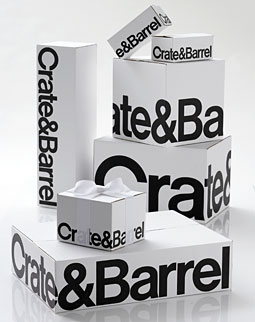
I just finished watching Helvetica, a documentary film by Gary Hustwit. I’ve been dying to see it since it was released, and finally got around to it this afternoon (I had convinced myself it was a daytime movie and not meant to be watched at night).
Less than two minutes into the film I realized that I needed to be taking notes. So instead of taking the runtime of 1 hour and 20 minutes, it took me approximately 3-1/2 hours to watch. I was so engrossed in what many of the designers and commentators were saying, and the ways in which it applies to my work, that I just had to keep hitting pause to write it all down.
Below are my notes on the film and on the typeface Helvetica. This is certainly no substitution for the film itself, which I highly encourage you to watch (available from Netflix) if you have any involvement whatsoever in the production of something that is meant to communicate.
Helvetica is the most used typeface on the planet.
- “Typefaces express a mood, an atmosphere. Give words a certain coloring.”
- It’s ubiquitous, beautiful, timeless. “Certain things shouldn’t be messed with”
- “The designer has an enormous responsibility. Those are the people putting the wires into our heads.”
Massimo Vignelli
“The life of a designer is a life of fight: fight against the ugliness. Just like a doctor fights against disease. For us, the visual disease is what we have around and what we try to do is to cure it somehow, with design.”

- Created the NYC Transit Signage in 1966 using Helvetica
- The distance between letters: the space between the black that really makes it
- There’s a dozen really good typefaces, “I use no more than three”
- “What Helvetica is: it’s a typeface that was generated by a desire of having better legibility. It is a modern type. It is a very clear type. It’s good for everything, pretty much.”
- In 1957 there was a need for rational typefaces that can be applied to all types of contemporary information, whether it’s sign systems or corporate identity, and present those visual expressions of the modern world to the public in an intelligible, legible way.
Wim Crowel
- “Grids are a tool of creating order, and creating order is typography”
- “You can’t do better design with a computer, but you can speed up your work enormously”
- The most neutral typeface: Helvetica
- “It should be neutral; it shouldn’t have a meaning in itself. The meaning is in the content of the text, not in the typeface.”
Harry Carter
“One of the most characteristic and to my mind beautiful things about Helvetica is these horizontal terminals, you see in the lower case a and c and e and g. The whole structure is based on this horizontal slicing off of the terminals.”
- Max Miedinger was the designer of Helvetica
- Helvetica’s first name was Neue Haas Grotesk
- “It’s a letter that lives in a powerful matrix of surrounding space”
- Max Miedinger was a salesman for Haas taking orders for foundry type
- Helvetica now owned by Linotype in Germany
- Marketing director at Stempel foundary gave it a better name because it was intended to be sold in the U.S.
- Helvetica literally means the Swiss typeface
- “It was exactly what designers were looking for. The figure-ground relationship properly executed. It was a landslide.”
Leslie Savan
“Helvetica makes corporations seem useful and efficient, but also the smoothness of the letters makes them seem almost human…by using Helvetica that can come off seeming more accessible, transparent, and accountable.”




Tobias Frere-Jones of Gotham Typeface (brother to Sasha Frere-Jones)
“The sort of classical modernist line on how aware a reader should be of a typeface is that they should be aware of it at all…But I don’t think it’s as simple as that. Even if they aren’t consciously of the typeface they’re reading, they’ll certainly be affected by it. The same way that an actor that’s miscast in a role will affect someone’s experience of a movie or play that they’re watching. They’ll still follow the plot, but be less convinced or excited or affected.”
Erik Spiekerman
- Why 50 years later is Helvetica still popular? “Why is bad taste ubiquitous? It’s a default; it’s air. You have to breathe so you have to use Helvetica.”
- “The aim with type design is always to make it individual enough so that it’s interesting, but of course 95% of any alphabet has to look like the other alphabet otherwise you wouldn’t be able to read it.”
- “Typefaces are a brand. You’re telling the audience, ‘This is for you,’ by using a certain typographic voice.”
“It’s like a person: if you are slightly heavy in the middle, you’re not going to walk around in tight t-shirts. You’d look like an idiot. And Helvetica is heavy in the middle. So it needs certain space around it, needs a lot of white space; it needs very carefully to look at the weight gradations. It needs a lot of space sideways also. Then it’s very legible. But very small and very tightly done and very lightly as modern designers do, it’s a nightmare, a total nightmare.”

.svg/251px-CourtTV_Logo_(2005-2007).svg.png)


Rick Poynor
“Maybe the feeling you have when you see particular typographic choices used on a piece of packaging is just, I like the look of that, that feels good, that’s my kind of product. But that’s the type casting its secret spell.”
Lars Muller
“This very serious typefaces tells you the dos and don’ts of street life….I think I’m right in calling Helvetica the perfume of the city. It’s something we don’t notice usually, but we would miss very much if it wouldn’t be there.”
“It’s the typeface of socialism because it is available all over and it’s inviting dilettantes and amateurs and everybody to do typography, to create their own type designs, and I think that’s a good thing.”
“By the 70s, especially in America, you start to get a reaction against what it seems to those designers is the conformity, the kind of dull blanket of sameness, that this way of designing is imposing on the world. So something that has come out of idealism has by this time become merely routine, and there’s a need for a change.”
Stefan Sagmeister
“Trying to look good limits my life.”
David Carson
“Don’t confuse legibility with communication. Just because something’s legible doesn’t mean it communicates. And more importantly doesn’t mean it communicates the right thing. And vice-versa, something that may be difficult to initially read may be sending a completely different message that is valid for where it’s being used, and that may require a little more time or the involvement of the reader….There’s a thin line between simple and clean and powerful, and simple and clean and boring.”
Danny van den Dungen of Experimental Jetset
“A lot of people connect Helvetica sometimes with the dangers of globalization and standardization. I’m not afraid for that quality at all because I know that everyone can put a twist on it. I think you can put as much nationality in the spacing of a typeface as in the typeface itself.”
Rick Poynor
“People are starting to see graphic communication as an expression of their own identity. And the classic case of this is the social networking programs such as MySpace where you can customize your profile — you can change the background, you can put pictures in, you can change the typeface to anything you want — and those choices, those decisions you make, become expressions of who you are. You start to care about it in a way that you wear the clothing that you’re wearing as an expression of who you are, or your haircut or whatever, or how you decorate your apartment — all of those things. We accept the idea of identity being expressed in that way though these consumer choices. But now it’s happening in the sphere of visual communication, and there’s no reason as the tools become ever more sophisticated, why this won’t just go on developing, and developing, and developing.”

Related Posts:
- Class Schedule for MFA in Interaction Design at SVA December 17, 2008 | 0 comments
- Video of Dan Saffer’s talk “Tap is the New Click” at IxDA NYC January 9, 2009 | 1 comments
- If I could tell designers one thing July 30, 2009 | 1 comments
- Sketching made easier by UI Stencils February 22, 2010 | 7 comments
- Get a 15% discount to DelveUI in NYC July 23, 2009 | 4 comments



I <3 Helvetica. Thanks for the awesome review!
Seesmic video reply from Disqus.
That is a great post for a great film.
I officially need to move Helvetica up on my NetFlix cue – it's been losing to 90210 DVDs lately ;)
Two bits of fun:
– Someone Flickr'ed the 1970 NYC Transit Standards manual – it's an amazing look at the science behind the science:
http://www.flickr.com/photos/triborough/sets/72…
– The MTA switched to “official” Helvetica sometime in the 1980s, but early signs were done in Akzidenz Grotesk (Standard Medium). This is the font dictated in the guide above.. (note this shot) http://www.flickr.com/photos/triborough/3347334…
Thanks for sharing :)
Awesome links! Thanks so so much for sharing these with us.
My favorite line (which you caught) was about the space around the text.
I found that to be so relevant to what we do as user experience designers — ensuring that not only the content is relevant and useful, but digestible and evenly paced (and spaced). Words can be powerful and moving, but there needs to be an appropriate rhythm, both in tone and in display, in order for the reader to be able to take it in, reflect on it and then take the desired action (whether that's to contribute in some way or read on). Without the white space, the black just bleeds together and letters are an indistinguishable, muddied mess. The same is true for the greater experience: there need to be rest stops. This reminds me both of my post “The User Experience of a Staircase” (http://whitneyhess.com/blog/2008/06/the-user-ex…) and Chris Fahey's presentation on seduction at Web 2.0 Expo NY (http://whitneyhess.com/blog/2008/09/web-20-expo…).
Did you see the Helvetica exhibit at the MOMA? I saw it last year and it was a small corner with a few things like a case of type and the NYC subway map done in Helvetica. Really neat. I don't know if it's still there. (I'm a bit surprised that you haven't seen the movie Helvetica until now.)
http://www.moma.org/exhibitions/exhibitions.php…